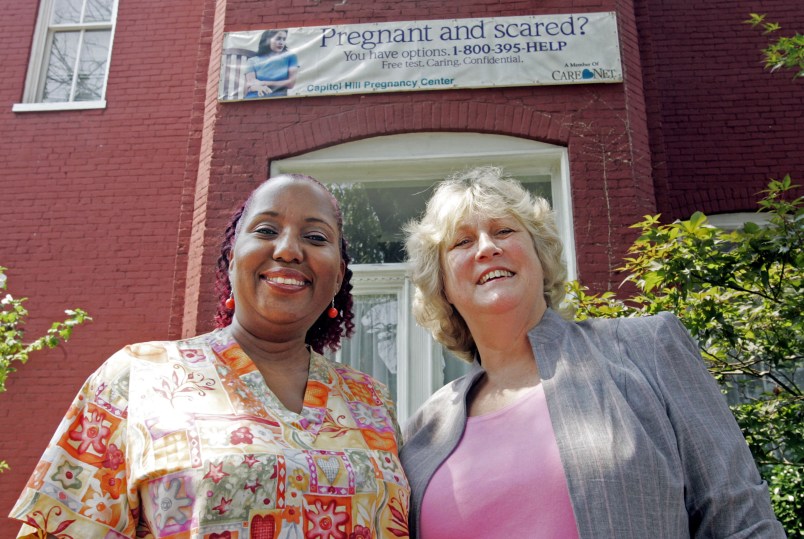The reproductive rights movement hasn’t had a lot of victories to be able to point to over the last few years, thanks to the onslaught of anti-abortion, anti-birth control bills slammed through state legislatures since 2011. One success it has been able to tout, however, has been their public awareness campaign against crisis pregnancy centers [CPCs].
These facilities often present themselves as medical clinics and offer medically inaccurate information on birth control and abortion. One particularly pernicious strategy they have been known to employ is to deceive visitors into believing they are abortion providers and delay women so long that they miss a window during which they can get to an actual doctor. Sometimes CPCs will give false information about the length of a person’s pregnancy — making her believe she is too late to get an abortion, or has far more time to arrange one than she really does under state laws.
After a series of undercover investigations, NARAL Pro-Choice America released a report on the practices of these self-proclaimed medical clinics, and that information lead to the centers having their Google ads removed online, calling them “deceptive.” With groups like Online for Life priding itself on its online campaign to get more pregnant people into CPCs first, before they visit a full-service reproductive health provider, having one avenue shut off is an important step.
The question is, of course, where the anti-abortion movement will go next. The answer? Back to new, more traditional advertising.
When Chicago residents board the L at the Fullerton stop, they can’t help but notice a new, glossy image on the wall. It depicts a worried looking young woman, and asks “Are You Late?” They aren’t referring to the train, of course, but a possible unplanned pregnancy, and the ad’s sponsor, “Aid for Women,” is there to offer help: free pregnancy testing, ultrasounds and counseling.
It is once you are on the website that you learn what sort of “counseling” they offer. They show three options: Adoption, parenting, and abortion. Under abortion they advise, “It may seem like having an abortion is the easy solution to an unplanned pregnancy, and you can just move on. It’s not that simple. Abortion is not a simple medical procedure without several possible risks and side effects. It can be a life-changing event with significant physical and emotional consequences. Many woman who have had past abortions continue to struggle with their abortion experience and wish they had been better informed about abortion procedures and the risks and side effects. Aid for Women will provide you with accurate abortion information and answer your questions so that you can make a fully-informed decision.”
Only after, in small italics, does the site note, “Aid for Women provides pregnancy support services and accurate information on all pregnancy options. Aid for Women does not perform or refer for abortions.”
Of course, none of the information about the organization’s opposition to providing abortion is listed on the L train ad, or on any of the other platforms across the transit system with the ads for Aid For Women. Also hidden in the ad is that “Aid For Women” is an arm of the local Catholic church, and that on their original site they are much more open about their true agenda.
“Aid for Women empowers women to make choices consistent with the dignity of the human person and the family,” their website reads. “Our message — of positive alternatives to abortion, the value of chastity and the noble and sacred role of motherhood — serves an ethnically diverse population of women in the Chicago metropolitan area. Each client is given unconditional compassion and the emotional, material and spiritual support she needs to choose life for her unborn baby and to plan a brighter future for herself and her children.”
In fact, the medical director of the organization, who is also a board member, is a former infertility specialist who gave up doing in vitro fertilization due to conflicts with Catholic doctrine, declaring that it “commoditizes” children and divorces them from marriage, and instead turned his focus to natural family planning (NFP) techniques. Between the demand for chastity and a focus on NFP, women turning to Aid for Women for help will be likely refused both a referral for abortion services and medically accurate information about hormonal birth control to prevent another unintended pregnancy.
Aid for Women would likely tell you that they aren’t deceiving anyone with their signs. They do in fact offer pregnancy tests, ultrasounds, counseling, and their services are free. What they aren’t doing is openly admitting how limited their “services” are, and how their counseling is meant to limit a pregnant person’s options.
Unfortunately, that is something we will continue to see more of, thanks to a slate of recent rulings overturning bills stating that CPCs need to be truthful in their advertising. The latest is in Austin, Texas, where not disclosing that the organization is neither a health center nor offers a full, unbiased discussion of reproductive options has been ruled protected speech.
“Under the ordinance, CPCs were required to publicly state that they do not offer abortions, make abortion referrals, or offer contraceptive services,” reports SEICUS. However, the CPC owners, who felt it violated their freedom of speech to be singled out and forced to declare services they did not offer, opposed the requirement.
After getting blocked from Google advertising, it’s not surprising to see that CPCs are redoubling their efforts when it comes to traditional advertising. Traditional ads such as billboards, bus side advertising, glossy posters at transit stops and similar, are much more costly, of course, but as it has become abundantly clear, the anti-abortion movement isn’t lacking in funds.
Picking transit, as well, is a smart move for CPCs, which often prey on pregnant people who are younger, poorer, and in more need of resources, be it a free pregnancy test or who are lacking in a health care provider to turn to either due to lack of or inadequate insurance.
What Aid for Women is doing is deeper than even that. The ad they placed in Chicago isn’t just deceptive by not acknowledging their lack of full reproductive choices, it conceals their true mission to coerce women and girls into a role of “traditional motherhood.” By setting up a separate façade, they have removed the ability for the pregnant person to make an informed choice on her own, while at the same time claiming that is the reason they engage in “counseling” in the first place.
In this case, just like in the case of the google ads, there is recourse. Many pro-choice advocates have been turning to the Chicago Transit Authority has a complaint center, where objections to the ad can be filed.
CPCs may legally have the right to not disclose their agenda when it comes to signage on their own clinics, but when it comes to advertising, those who host the ads are the final arbitrators on what is deceptive and what is not.
Robin Marty is a freelance writer, speaker and activist, and the author of Crow After Roe: How Women’s Health Is the New Separate But Equal and How to Change That. Robin’s articles have appeared at Politico Magazine, Rolling Stone, Bitch Magazine, Ms. Magazine, In These Times and other publications.









